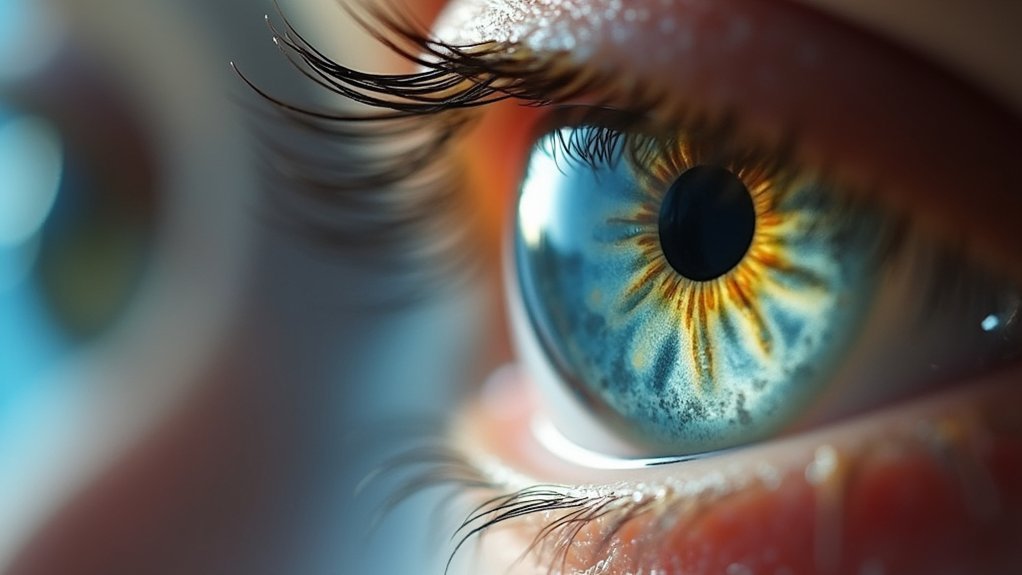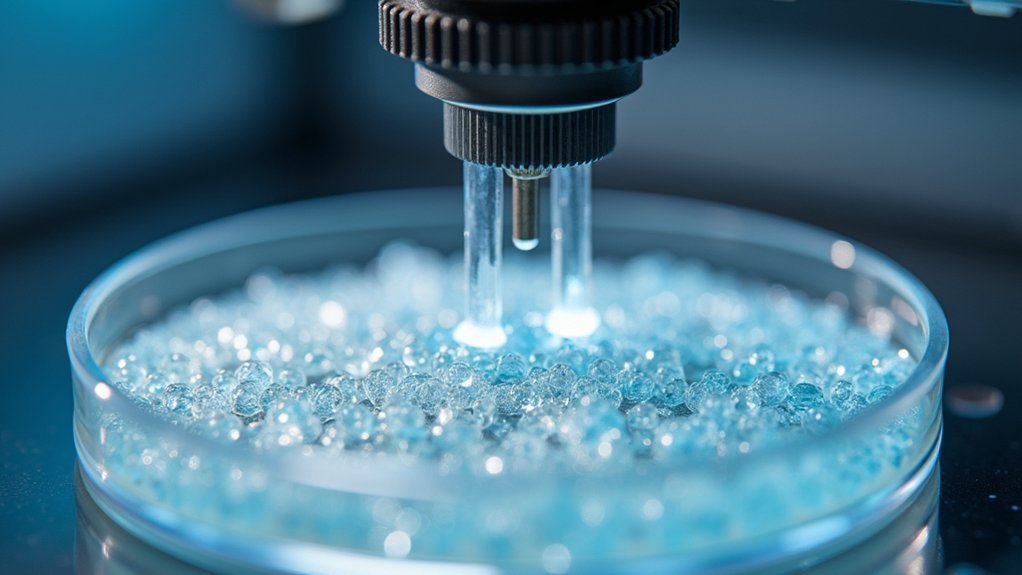You’ll discover bioprinted corneas offer a breakthrough solution to restore vision when over 12.7 million people worldwide wait for transplants that may never arrive. Unlike donor corneas, bioprinted versions use your own stem cells, eliminating rejection risks and the need for lifelong immunosuppressive drugs. Advanced laser technology creates personalized corneas layer by layer, achieving optical clarity that matches natural tissue while treating conditions like keratoconus. Explore how this revolutionary technology transforms global eye care.
Critical Shortage of Donor Corneas Worldwide

The global demand for corneal transplants far exceeds the available supply, creating a devastating healthcare crisis that affects millions worldwide.
You’re looking at over 12.7 million people currently waiting for transplants, while only about 9,000 procedures happen annually in Germany alone. This stark disparity reveals the magnitude of donor tissue shortages plaguing healthcare systems globally.
You’ll find that strict medical standards further limit available corneas. Age, health conditions, and preservation time constraints disqualify many potential donors.
Developing countries face even greater challenges with inadequate infrastructure and limited organ donation awareness.
As corneal blindness from diseases, injuries, and infections continues rising, traditional transplant methods can’t meet demand.
This urgent crisis makes bioprinting technology essential for developing sustainable alternatives to restore vision for millions.
Eliminating Transplant Rejection Through Personalized Bioinks
When you receive a bioprinted cornea made from your own stem cells, you’re fundamentally getting a transplant that your immune system recognizes as belonging to you.
This personalized bioink approach dramatically reduces the immunoreactivity that typically causes traditional donor cornea rejection, creating a hypoimmunogenic transplant that’s far more compatible with your body.
You’ll benefit from enhanced biocompatibility that not only improves your chances of successful transplantation but also aligns with the cutting-edge principles of personalized medicine.
Patient-Derived Stem Cells
Although traditional corneal transplants have helped millions regain their sight, they’ve always carried the significant risk of immune rejection, forcing patients to rely on lifelong immunosuppressive medications.
Patient-derived stem cells revolutionize this approach by creating personalized bioinks that virtually eliminate rejection risks. When you undergo bioprinting procedures using your own stem cells, you’re receiving corneal tissue that’s genetically identical to your immune system.
This bioprinting innovation guarantees ideal compatibility since the cells recognize themselves as native tissue. The process involves harvesting your stem cells, incorporating them into specialized bioinks, then precisely printing replacement corneal tissue.
Your body readily accepts these bioprinted corneas because they’re created from your cellular material, making corneal regeneration safer and more effective than traditional transplantation methods.
Biocompatibility Reduces Immunoreactivity
Beyond eliminating rejection risks, bioprinted corneas achieve remarkable biocompatibility through hypoimmunogenic materials that seamlessly integrate with your eye’s natural architecture.
When you receive a bioprinted cornea created from your own stem cells, you’re getting tissue that your body recognizes as familiar rather than foreign. This personalized approach in tissue engineering dramatically reduces immunoreactivity compared to traditional donor transplants.
The bioprinting process tailors corneas to your specific eye geometry and curvature, ensuring ideal integration.
Rigorous in-vitro testing validates structural integrity and optical clarity before transplantation.
Whether using your patient-derived cells or carefully matched universal donor stem cells, the biocompatibility achieved through this innovative technology means your immune system won’t mount an aggressive response, creating conditions for successful vision restoration without long-term immunosuppressive medications.
Personalized Bioink Advantages
Personalized bioinks revolutionize corneal transplantation by creating tissues from your own cellular material, effectively eliminating the fundamental cause of rejection.
When you use your own stem cells, you’re getting hypoimmunogenic corneas that your body readily accepts without triggering harmful immune responses. This personalized approach means your bioprinted corneal tissue matches your unique cellular composition and eye curvature perfectly, ensuring ideal compatibility and function.
Each cornea undergoes extensive in-vitro testing to meet natural tissue standards before implantation.
You’re not dependent on donor availability or compatibility matching anymore. This advancement in regenerative medicine transforms how corneal disorders are treated, offering you a reliable, personalized solution that integrates seamlessly with your ocular environment while reducing reliance on traditional donor tissues.
Laser-Based 3D Printing Technology for Corneal Creation
You’ll experience corneal restoration through cutting-edge laser technology that builds functional tissue layer by precise layer.
The KeratOPrinter project represents this breakthrough, where focused laser beams carefully deposit chemically modified collagen fibers to create transparent, structurally sound corneas.
You’ll benefit from personalized bioinks developed specifically from your own stem cells, ensuring the printed cornea matches your unique biological profile perfectly.
Precision Laser Printing Process
While traditional corneal transplants depend on donor availability, laser-based 3D bioprinting technology revolutionizes vision restoration by constructing corneas layer by layer with unprecedented precision.
You’ll benefit from precision laser printing that guarantees accurate curvature and structural integrity essential for ideal vision. The process uses personalized bioinks created from your own stem cells, dramatically reducing immune rejection risks.
Chemically modified collagen fibers enhance the bioink’s mechanical properties and biocompatibility, creating a fully functional human cornea. Advanced AI-driven quality control measures monitor each printed layer, assuring optical clarity and structural standards.
This innovative approach produces transparent, functional corneas that effectively restore vision while addressing the critical shortage of donor corneas worldwide.
Personalized Bioink Development
Building on this precise printing foundation, the bioink itself represents a groundbreaking advancement in personalized medicine.
You’re witnessing a revolutionary shift where personalized bioink derived from your own stem cells eliminates the primary threat of immune rejection that plagues traditional corneal transplants. This living tissue engineering approach creates corneas specifically tailored to your anatomical requirements, dramatically improving success rates.
The personalized bioink development offers four key advantages:
- Zero rejection risk – Your own stem cells guarantee perfect biological compatibility
- Custom fit design – Corneas match your exact eye geometry and optical needs
- Enhanced healing – Living tissue integrates seamlessly with existing eye structures
- Unlimited availability – No more waiting lists for donor organs
This innovation transforms corneal transplants from a scarcity-dependent procedure into an accessible, patient-specific solution.
Using Patient-Derived Stem Cells for Tissue Engineering

Since traditional corneal transplants face significant challenges with immune rejection and donor shortages, patient-derived stem cells offer a revolutionary solution for bioprinting personalized corneal tissues.
You’ll benefit from using your own biological material, which dramatically reduces rejection risks and promotes better graft integration.
When you employ patient-derived stem cells, you’re creating corneal tissues that mirror your unique structural and functional characteristics.
This personalized approach addresses your specific cellular needs and disease variations.
Through specialized differentiation techniques, scientists generate essential corneal cell types like epithelial cells and keratocytes, maintaining transparency and integrity.
This innovative method doesn’t just solve donor shortages—it enables scalable, on-demand production of customized corneal tissues.
You’ll receive treatment tailored specifically to your biochemical requirements, maximizing restoration potential.
Treating Keratoconus and Progressive Corneal Disorders
When you’re diagnosed with keratoconus, you face a progressive condition that causes your cornea to thin and bulge into a cone shape, affecting roughly 1 in 300 people worldwide and potentially leading to severe vision impairment or blindness without treatment.
Traditional treatments like corneal cross-linking only work at specific disease stages and aren’t suitable for all patients. That’s where bioprinting technology offers revolutionary hope through the KeratOPrinter project.
Here’s how bioprinting transforms keratoconus treatment:
- Personalized bioinks – Created from your own stem cells for ideal compatibility
- Precise corneal geometry – Bioprinted with exact curvature and cell alignment for clear vision
- Reduced rejection risk – Hypoimmunogenic corneas minimize transplant complications
- Scalable solution – Addresses donor corneal shortage while improving patient outcomes
This innovation could revolutionize ophthalmology for progressive corneal disorders.
Achieving Optical Clarity Through Precise Bioprinting

The success of bioprinted corneal transplants hinges on achieving perfect optical clarity, which requires nanometer-level precision in cellular arrangement and structural composition.
You’ll find that advanced 3D bioprinting techniques construct your cornea layer by layer, ensuring precise curvature and alignment that’s essential for transparency and proper light refraction.
Your bioprinted cornea incorporates patient-derived stem cells and chemically modified collagen fibers within specialized bioinks, mimicking natural corneal structure more effectively.
AI-driven quality control assesses microstructural patterns, ensuring each bioprinted cornea meets stringent optical clarity standards while reducing post-transplant complications.
Through rigorous in-vitro testing, researchers confirm that bioprinted corneas match or exceed natural tissue clarity.
You’ll benefit from customized geometry based on your unique eye parameters, creating optically clear corneas tailored specifically for your vision restoration needs.
Scaling Manufacturing for Global Healthcare Access
While achieving optical clarity represents a major breakthrough, manufacturing bioprinted corneas at scale presents the next frontier in addressing global vision loss.
You’re witnessing how 3D bioprinting technology transforms from laboratory innovation to worldwide solution. The KeratOPrinter project’s collaborative approach across nine EU partners demonstrates how strategic partnerships accelerate production capabilities while reducing operational costs.
This scaling revolution directly impacts accessibility for underserved populations who’ve been waiting too long for cornea donations.
Consider these transformative manufacturing advantages:
- On-demand production eliminates dependency on limited donor tissues
- AI-driven quality control guarantees consistent structural integrity across batches
- GMP compliance streamlines regulatory approval processes
- Cost reduction makes treatments affordable for developing regions
You’ll see how this systematic approach addresses the 12.7 million people worldwide desperately needing corneal transplants.
Regulatory Pathways for Clinical Implementation
Before bioprinted corneas can restore vision in patients worldwide, you’re maneuvering a complex web of regulatory requirements that determines whether this groundbreaking technology reaches those who need it most.
These regulatory pathways demand strict adherence to Good Manufacturing Practices throughout production, guaranteeing consistent quality and patient safety standards.
You’ll need thorough pre-clinical testing data validating safety and efficacy before human trials begin. Ethics board approvals are mandatory, scrutinizing every aspect of tissue use.
The EU’s fast-track system offers hope for expedited approvals of innovative bioprinted corneas.
Detailed traceability becomes critical—you must document cell origins, growth conditions, and manufacturing processes.
This documentation guarantees regulatory compliance while maintaining the highest patient safety standards throughout clinical implementation.
Cost-Effective Alternative to Traditional Transplantation
As bioprinting technology matures, you’re witnessing a revolutionary shift that promises to dramatically slash the financial burden of corneal transplantation.
This cost-effective approach transforms how healthcare systems address vision restoration, making treatment accessible to millions who can’t afford traditional procedures.
Bioprinting corneas offers these economic advantages:
- Eliminated donor procurement costs – You’ll bypass expensive tissue acquisition and processing fees that drive up traditional transplant expenses.
- Reduced rejection complications – Personalized bioinks from your stem cells minimize costly post-operative treatments and revision surgeries.
- Streamlined manufacturing – 3D bioprinting accelerates production while consuming fewer resources than conventional donor cornea preparation.
- Scalable production – Mass production capabilities lower per-unit costs, making corneas affordable for healthcare systems serving the 12.7 million patients awaiting transplants worldwide.
Frequently Asked Questions
Can Getting a Corneal Transplant Make Your Vision Better?
You’ll likely experience considerably improved vision after a corneal transplant, with about 90% of patients reporting better sight. The procedure replaces your damaged cornea with healthy donor tissue, restoring visual clarity.
Has the Artificial Cornea Restored Vision?
You’ve seen promising results from artificial corneas in clinical trials, where patients experienced significant improvements in visual acuity. Some participants achieved vision comparable to those with healthy natural corneas.
How Does Reshaping the Cornea Improve Vision?
When you reshape your cornea, you’re correcting its curvature to properly focus light onto your retina. This eliminates blurriness caused by irregular shapes, greatly improving your visual acuity and overall sight quality.
What Is the Significance of 3D Bioprinting in Regenerative Medicine?
You’re witnessing medicine’s transformation through 3D bioprinting, which creates personalized tissues from living cells. This technology eliminates donor shortages, reduces transplant rejection risks, and enables precise organ replacement tailored to your unique anatomy.





Leave a Reply